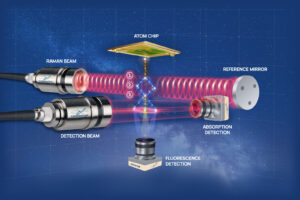Quantum Sensors in Space

The impact of climate change is one of the most severe challenges of the 21st century. It is therefore of high importance to understand the underlying processes and causalities. A powerful tool to gain this vital knowledge on a global scale is the satellite-based observation of changes in Earth’s mass distribution e.g. from melting glaciers or loss of groundwater. The required high-precision measurements are reachable with novel quantum sensors. Due to the extensive European heritage and a close collaboration within the European Union an independent development and operation of a quantum sensor based space mission can be realised.
Quantum sensors in space:
a technological breakthrough
Classical electrostatic accelerometers used so far in gravimetry missions present increased noise at low frequency and long-term drifts that limit the ability to reconstruct the Earth’s gravity field at long wavelength and to accurately model its temporal fluctuations. These limitations have generated a broad interest in disruptive technologies, based on Cold Atom Interferometry (CAI), that measure the acceleration of freely falling independent atoms by manipulating them with laser light. These systems, free from most systematic errors that affect classical systems, provide higher sensitivity at long wavelength, drift-free measurements, and higher absolute accuracy, leading to accurate long-term measurements and comparisons. On the Earth, state-of-the-art CAI has reached an accuracy in the low nano-g range for absolute gravimeters and a differential acceleration sensitivity of order of the nano-g/m for gravity gradiometry. In space, where the quantum superposition in CAIs may be maintained for seconds well beyond what can be reached on ground, the sensitivity at long wavelength is expected to be several orders of magnitude higher, thus outperforming the best classical devices while contributing to improved measurements of climate change-related mass transport products. In particular, the improved long-term stability of quantum sensors is promising for significantly more accurate understanding of mass transport processes at large scales. Despite its recent progress, this innovative technology is currently not considered mature enough , i.e. a low Technology Readiness Level (TRL), to be ready for operation in space at its best potential level of performance. Indeed, operating a quantum sensor in space represents a major scientific and technical challenge. First, it is necessary to understand and simulate the performance of these instruments in the context of space gravimetry missions to fully benefit from their performance. Second, the operation of these instruments on a satellite requires specific development to be adapted to microgravity conditions and a dedicated qualification for the space environment.




